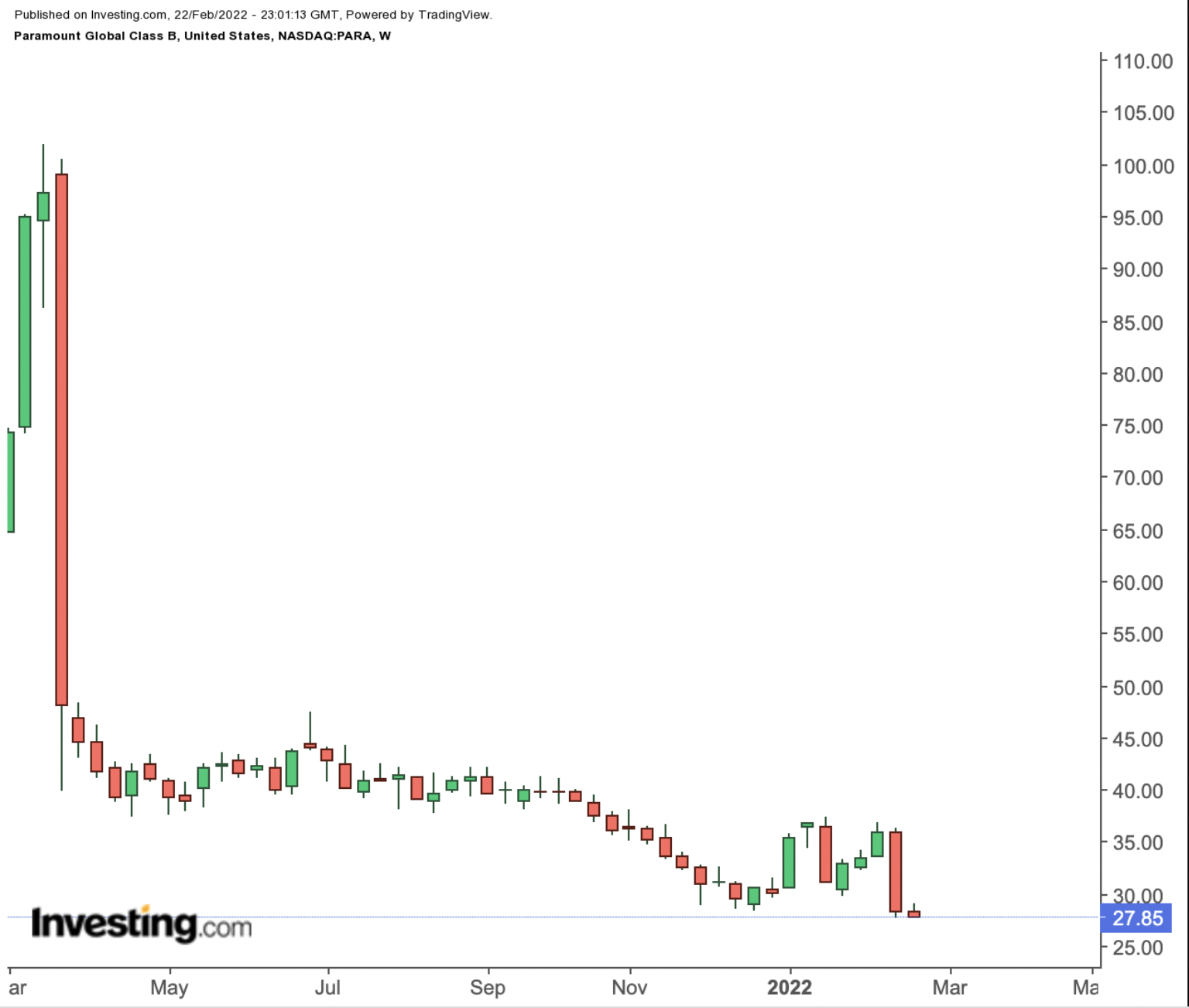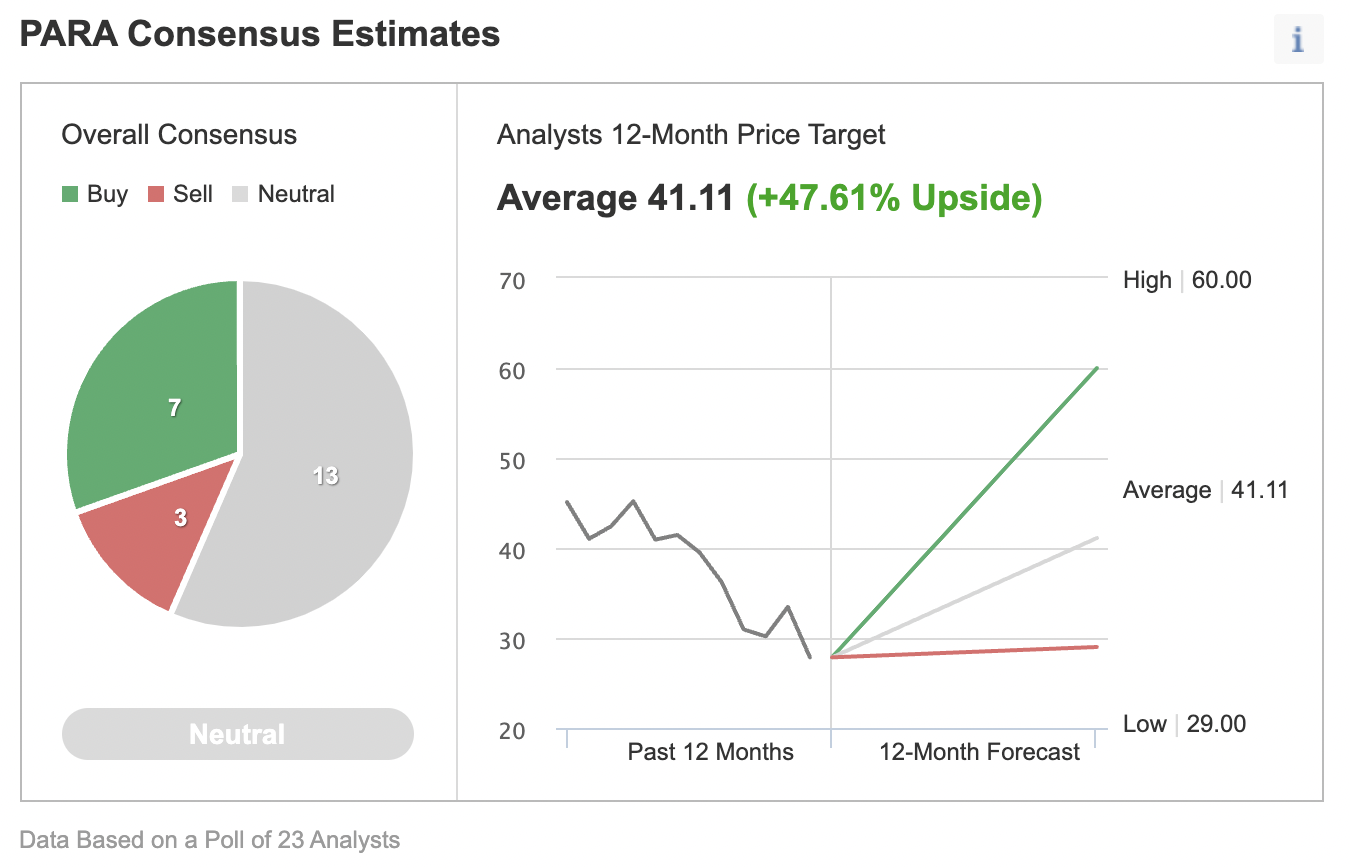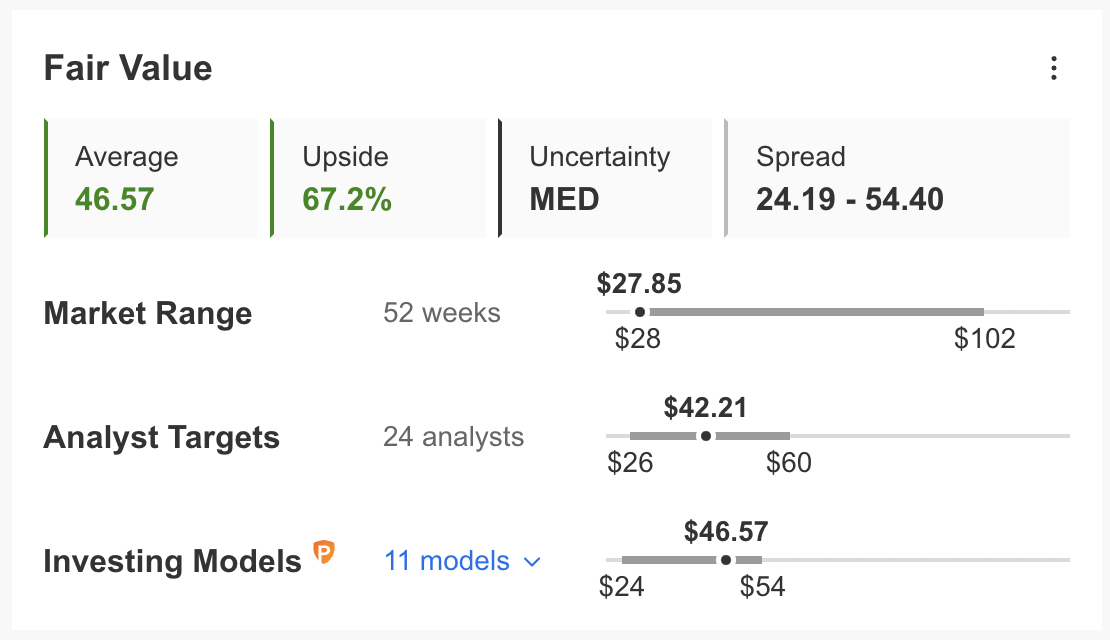- Shares of broadcasting and entertainment giant Paramount Global, formerly known as ViacomCBS, are down more than 55% in the last year
- Despite the recent lukewarm financials, management has robust expectations from the streaming business
- Long-term investors could consider buying PARA stock around these levels
Broadcasting heavyweight Paramount Global (NASDAQ:PARA) stock declined 57.1% in the past 52 weeks and 5.9% year-to-date. For comparison, the Dow Dow Jones Broadcasting & Entertainment index lost 19.6% in the past year and 6.4% since the start of 2022.
Paramount Global is the company that, until Feb. 16, was known as ViacomCBS.

On Mar. 15, 2021, PARA shares traded above $101, hitting a multi-year high. But since then, they have lost more than 70%. The stock’s 52-week range has been $27.62 - $101.97, while the company’s market capitalization stands at $18.06 billion.
The entertainment group released Q4 financials on Feb.15. Revenue was $8 billion, implying an increase of 16% Year-over-Year (YoY). While advertising revenue was almost flat at $2.6 billion, streaming came in at $1.3 billion, representing a 48% YoY increase.
Shows, including Clifford The Big Red Dog, Mayor of Kingstown, and 1883 as well as NFL games provided tailwinds for the company. However, the bottom line was below market expectations. Non-GAAP adjusted diluted earnings per share were 26 cents versus $1.04 a year ago.
On these metrics, CEO Bob Bakish commented:
“We achieved our best quarter ever in streaming subscription growth – more than doubling our subscriber additions from last quarter with a record 9.4 million additions, expanding our total global streaming subscribers to over 56 million.”
The newly renamed Paramount raised its global streaming subscriber goal to more than 100 million subscribers, up from the previous target of 65 - 75 million, by the end of 2024. Readers might be interested to know that according to data analytics group Nielsen (NYSE:NLSN), in January, the largest market share in streaming in the US was held by Netflix (NASDAQ:NFLX) with 6.6%. Then came YouTube–parent company Alphabet (NASDAQ:GOOGL), followed by Hulu–parent company Walt Disney (NYSE:DIS), and then PrimeVideo–parent company Amazon (NASDAQ:AMZN).
Despite the upbeat tone of management, especially regarding streaming ambitions, investors were not impressed with the results. Prior to the release of the quarterly metrics, PARA stock was around $35. On Feb. 18, it fell to an intraday 52-week low of $27.62. Intraday, shares were around $29.10.
What To Expect From Paramount Global Stock
Among 23 analysts polled by Investing.com, PARA stock has a "neutral" rating. Wall Street also has a 12-month median price target of $41.11 for the stock, implying an increase of roughly 46% from current levels. The 12-month price range currently stands between $29 and $60.

Source: Investing.com
Similarly, according to a number of valuation models, like those that might consider P/E or P/S multiples or terminal values, the average fair value for Paramount Global stock via InvestingPro stands at $46.57.

Source: InvestingPro
In other words, fundamental valuation suggests PARA shares could increase about 65%.
At present, PARA’s P/E, P/B, and P/S ratios are 4.3x, 0.7x, and 0.8x respectively, which are favorable when compared to metrics for peers which stand at 10.2x, 1.7x, and 0.9x.
Finally, those who also pay attention to technical charts might be interested to know that several of PARA's short- and intermediate-term indicators are at oversold levels, signaling that the rapid sell-off might be over for now.
Our expectation is for PARA stock to trade in a range and build a base between $26 and $29 in the coming weeks. Afterwards, Paramount Global shares could potentially start a new leg up.
Covered Calls On PARA Stock
Intraday Price: $29.10
Paramount Global bulls who believe the decline in the stock is likely to come to an end could consider investing now. The target price would be $41.11, analysts’ forecast.
Alternatively, investors who are long-term bullish on PARA shares but concerned about the short-term volatility might use options. For instance, they could put together a covered call position. We have covered numerous examples before using Apple, AMD, Micron Technology or Starbucks for example.
For every 100 shares of PARA held, the strategy requires the trader to sell one call option with an expiration date at some time in the future.
Intraday Tuesday, Paramount Global stock was trading at $29.10. Therefore, for this post, we'll use this price.
A stock option contract on PARA (or any other stock) is the option to buy (or sell) 100 shares.
Investors who believe there could be further volatility or profit-taking soon might use a slightly in the money (ITM) covered call. A call option is ITM if the market price (here, $29.10) is above the strike price ($27.50).
So, the investor would buy (or already own) 100 shares of Paramount Global stock at $29.10 and, at the same time, sell a PARA May 20 27.50-strike call option. This option is currently offered at a price (or premium) of $3.45.
An option buyer would have to pay $3.45 X 100 (or $345) in premium to the option seller. This call option will stop trading on Friday, May 20.
This premium amount belongs to the option writer (seller) no matter what happens in the future, for example, on the day of expiry.
Assuming a trader would now enter this covered call trade at $29.10, at expiration, the maximum return would be $185, i.e., ($345 - ($29.10 - $27.50) X 100), excluding trading commissions and costs.
Risk/Reward Profile For Unmonitored Covered Call
An ITM covered call's maximum profit is equal to the extrinsic value of the short call option.
The intrinsic value would be the tangible value of the option if it were exercised now. Thus, our PARA call option's intrinsic value is ($29.10 - $27.50) X 100, or $160.
The extrinsic value is the difference between the market price of an option (or the premium) and its intrinsic price. In this case, the extrinsic value would be $185, i.e., ($345 - $160). Extrinsic value is also known as time value.
The trader realizes this gain of $185 as long as the price of Paramount Global stock at expiration remains above the call option's strike price (i.e., $27.50).
On expiration day, if the stock closes below the strike price, the option would not get exercised, but would instead expire worthless. Then, the stock owner with the covered call position gets to keep the stock and the money (premium) s/he was paid for selling the option.
At expiration, this trade would break even at a PARA stock price of $25.65 (i.e., $27.50 - $1.85), excluding trading commissions and costs.
Another way to think of this break-even price is to subtract the call option premium ($3.45) from the underlying PARA stock price when we initiated the covered call (i.e., $29.10).
On May 20, if PARA stock closes below $25.65, the trade would start losing money within this covered call setup. Therefore, by selling the covered call, the investor has some protection against a potential loss in the case of a decline in the underlying shares. In theory, a stock's price could drop to $0.
Bottom Line
Paramount Global has come under significant pressure in recent months. However, Wall Street is still bullish on the company.
The exact market timing of when PARA shares could take a breather is difficult to determine, even for professional traders. But options strategies, like covered calls, provide tools that might prepare for sideways moves or even further drops in price.
